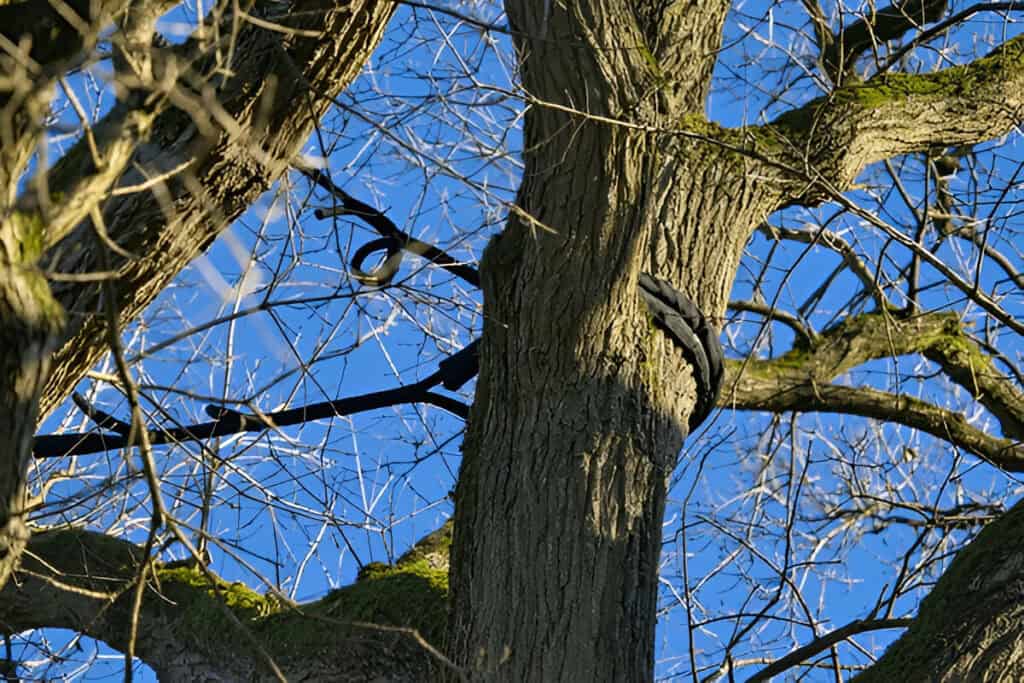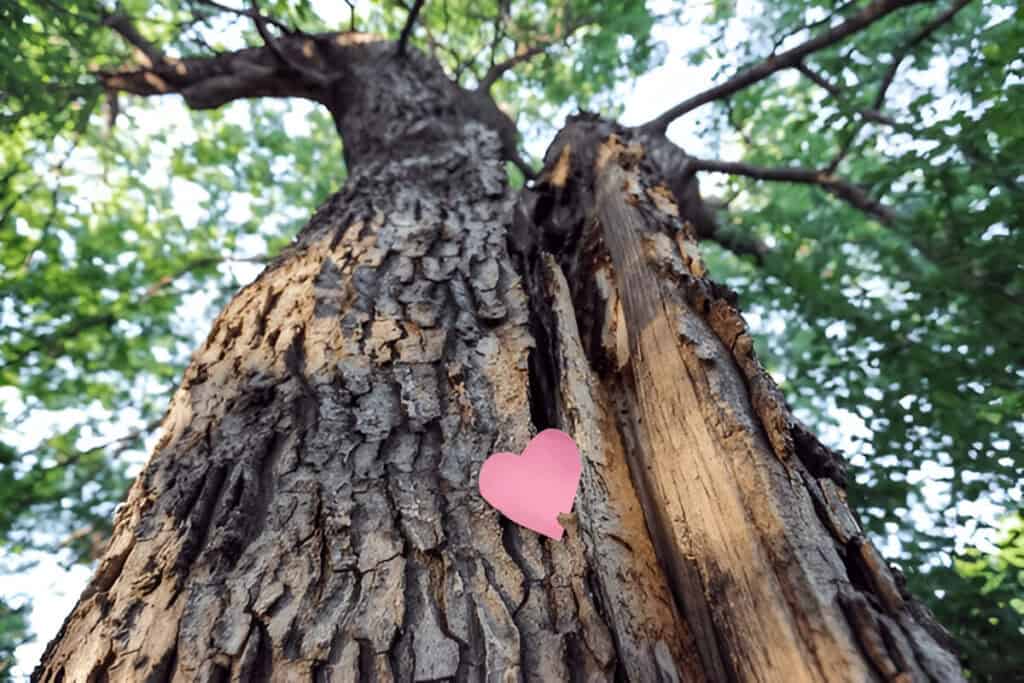Cabling and Bracing Service , Evansville
Want to protect your valuable trees from storm damage and decay? We’ll strengthen your trees with professional cabling and bracing. Our certified arborists use steel cables and braces to support weak branches and prevent splits. You’ll get 24/7 service and a free assessment to keep your trees healthy for years to come. In fact, proper cabling can extend a tree’s life by 15-20 years when installed early enough.
GET A FREE ESTIMATE
Understanding Tree Cabling and Bracing
Tree cabling and bracing are vital techniques that protect and preserve large or structurally compromised trees. When trees have weak branch unions, split trunks, or heavy limbs, these methods provide crucial support to prevent failure and extend tree life.
Tree Cabling
Cabling involves installing high-strength steel cables between major branches or stems to reduce stress on weak areas. These cables, typically installed two-thirds of the way up from where branches meet, limit excessive movement during storms and distribute weight more evenly. Research shows that proper cabling can add 15-20 years to a tree’s lifespan.
Bracing
Bracing uses threaded steel rods that go directly through branches or trunks to reinforce split or weak areas. This technique provides rigid support where cabling alone isn’t enough. It’s especially effective for V-shaped branch unions, which are prone to splitting.
Professional installation is crucial – improper techniques can damage trees or create safety hazards. Certified arborists assess factors like tree species, size, age, and structural issues to determine the right support system. Regular inspections (every 2-3 years) ensure hardware remains secure and effective.
These preventive measures typically cost $500-1500 but save thousands in potential property damage and tree removal costs. They’re particularly valuable for protecting historic trees and those near structures.
When Is Cabling and Bracing Necessary?
Cabling and bracing become necessary in several specific situations:

- Split or weak branch unions, especially V-shaped connections that show signs of cracking
- Storm damage leaves branches or trunks compromised but salvageable
- Large trees with heavy horizontal limbs extending over structures
- Historic or high-value trees showing signs of structural weakness
- Multi-stemmed trees with included bark between stems
Warning signs that indicate immediate need:
- Visible cracks in major branches
- Leaning trunk
- Recent storm damage
- Dead or dying sections
- History of falling branches
Best time for installation: Late fall to early spring when trees are dormant and have less foliage weight. Emergency installations can be done year-round if safety risks exist.
Important: Not every damaged tree is a candidate. Trees with severe decay (over 40% trunk decay) or root problems typically need removal instead. A certified arborist can assess if cabling and bracing will effectively preserve your tree.
How Are Cabling and Bracing Installed?
Professional installation of tree cabling and bracing follows these key steps:
- Assessment: Arborist evaluates tree structure, identifies weak points, and designs support system
- Hardware Selection:
- Cables: Extra high-strength steel (EHS) or synthetic cables
- Bracing rods: Threaded steel rods sized to tree diameter
- Attachment hardware: Eye bolts, lags, or through-bolts
- Installation Process:
- Drilling precise holes for hardware
- Installing bracing rods through weak unions
- Placing cables at 2/3 height of supported branches
- Tensioning cables properly (not too tight/loose)
- Safety Standards:
- Must meet ANSI A300 standards
- Proper hardware sizing per tree size
- Correct installation angles and heights
- Regular inspection schedule established
Cost typically ranges $300-1500 depending on tree size and system complexity. Installation requires specialized equipment and expertise – never attempt DIY cabling/bracing due to safety risks.
Annual inspections are recommended to check hardware integrity and adjust tension as needed.
Benefits of Tree Cabling and Bracing
Protecting Your Investment
When you choose our Evansville tree service for cabling and bracing, you’re making a smart investment in your property’s future. Professional support systems can extend your tree’s life by 15-20 years, saving you thousands in potential removal costs. Mature trees boost your property value by up to 19%, making preservation crucial for your landscape’s worth.
Safety and Peace of Mind
Our certified arborists will assess your trees’ structural integrity and install the right support system to prevent accidents. With proper cabling and bracing, you’ll dramatically reduce the risk of storm damage and falling branches. This proactive approach helps you avoid emergency situations that often cost between $800-2,000 to address.
Cost-Effective Prevention
Think of cabling and bracing as preventive medicine for your trees. By addressing structural issues early, you’ll avoid more expensive problems down the road. Many insurance companies even offer reduced rates for properly maintained trees, recognizing the decreased liability risk.
Local Expertise
You Can Trust Our team has protected over 1,000 Evansville trees in the past decade. We understand our local climate and tree species, providing you with customized solutions backed by our satisfaction guarantee. Regular inspections ensure your investment stays secure year after year.
Ready to protect your trees? Contact us today for a free assessment and learn how we can help preserve your valuable trees for generations to come.
Cabling and Bracing Service , Evansville
Over 175 ⭐⭐⭐⭐⭐ Reviews from Our Customers
Signs Your Trees Need Cabling and Bracing
Visible Structural Issues
Your trees may show noticeable cracks along the trunk or major branches. Watch for V-shaped branch unions with included bark, as these connections are naturally weaker and prone to splitting. Multiple trunks growing from the same base often signal future structural problems.

Storm Damage Concerns
If your tree has survived recent storms but shows new splits or cracks, immediate support can prevent further damage. Trees with a history of dropped branches during storms are prime candidates for cabling and bracing.
Location Risk Factors
Trees overhanging your home, garage, or power lines need extra attention. When large branches extend horizontally over structures, the added weight creates stress points that benefit from support systems.
Signs of Movement
Look for soil heaving around the root zone or a gradually increasing lean in the trunk. These changes often indicate root or structural issues that professional cabling can help manage.
Age and Species Considerations
Certain species common to Evansville, like Silver Maples and Bradford Pears, naturally develop weak branch structures as they age. Trees over 20 years old with multiple leads often need supplemental support to prevent failure.
Call our certified arborists for a free assessment if you notice any of these warning signs. Early intervention can save your valuable trees and protect your property.

